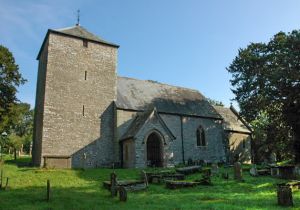
History
Maelog was the son of a chieftain in what is now south west Scotland, and a brother of St Gildas. The church was founded in the early medieval period but the current building is almost entirely a Victorian rebuilding, save for the west tower, which dates to the 16th century.
The Cross of Briamail (Brianmail Flou)
The treasure of St Maelog's church is a 10th century Celtic cross-slab, cared with an incised cross, a figure of a warrior, and a Latin inscription. The cross originally stood in the churchyard, but has been moved under the north tower arch inside the church to preserve it from weathering.
The cross stands 8 feet high and has been dated to some time between 900-950 AD. At the top is a Celtic cross, surrounded by a ribbon interlace pattern, and what appears to be a large letter 'S'. Under the cross is the figure of a warrior with a short sword and spear. Under the figure is a Latin inscription, and under this is key-pattern decoration.
The inscription reads 'BRIAMAIL FLOU', or 'The Cross of Briamail'. Who was Briamail? He could be the 6th century St Briavel, a hermit who lived just across the River Wye at St Briavels, Gloucestershire. Or perhaps the inscription refers to St Maelog, after whom the church is named.
There used to be a second carved stone at Llandefaelog. The stone was recorded in the 19th century as being carved with the name 'CATVC', probably a reference to St Cattwg, or Cadoc.
Other historic features include a 13th century font, an ornate Victorian reredos, a pair of 18th century marble monuments against the north wall of the nave, and a group of interesting 16th-17th century grave slabs. In the churchyard is a striking 1816 mausoleum in Egyptian style for the owners of the Penoyre estate.
St Maelog's is open daily to visitors.
 We've 'tagged' this attraction information to help you find related historic attractions and learn more about major time periods mentioned.
We've 'tagged' this attraction information to help you find related historic attractions and learn more about major time periods mentioned.




